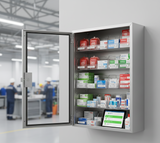Beyond the Daily Grind: Essential Emergency Preparedness for Every Workplace
In the hustle and bustle of daily operations, it's easy to focus solely on the immediate tasks at hand and the routine safety measures. We put on our PPE, follow protocols, and manage daily risks. But what about the unexpected? What happens when a fire alarm blares, a natural disaster strikes, or a medical emergency unfolds?
At Your Safety Company, we understand that true workplace safety extends beyond the daily grind. It encompasses a proactive approach to being prepared for the unforeseen. Emergency preparedness isn't just a regulatory requirement; it's a fundamental commitment to protecting your most valuable assets: your employees and your business.
Why Emergency Preparedness Can't Be an Afterthought
Ignoring emergency preparedness can have devastating consequences, from severe injuries and fatalities to significant property damage and business disruption. A well-thought-out emergency plan ensures:
-
Employee Safety: The primary goal is to protect lives by providing clear procedures for evacuation, shelter-in-place, and immediate aid.
-
Reduced Damage: Quick and organized responses can minimize property loss and mitigate the impact of an incident.
-
Business Continuity: A robust plan helps your business recover faster and resume operations, reducing financial losses.
-
Legal Compliance: Many industries have specific regulations regarding emergency planning, and adherence avoids penalties.
-
Peace of Mind: Knowing your team is prepared fosters a safer, more confident work environment.
Key Pillars of Workplace Emergency Preparedness
Building a comprehensive emergency plan involves several critical components:
1. Risk Assessment & Planning
Every workplace is unique. Start by identifying potential hazards specific to your location and industry. This includes:
-
Natural Disasters: Earthquakes, floods, tornadoes, blizzards, wildfires.
-
Man-Made Incidents: Fires, chemical spills, power outages, active threats, civil unrest.
-
Medical Emergencies: Sudden illnesses, injuries.
Once risks are identified, develop clear, written emergency action plans (EAPs) for each scenario. These plans should outline roles, responsibilities, communication protocols, and specific actions to take.
2. Communication Systems
During an emergency, clear and immediate communication is paramount. Establish:
-
Internal Communication: How will you alert employees (alarms, PA systems, text alerts, designated messengers)? How will they report their status?
-
External Communication: How will you contact emergency services (911)? How will you inform family members or stakeholders?
-
Designated Meeting Points: Clear, safe assembly areas outside the building.
3. Essential Supplies & Equipment
Having the right tools on hand can make all the difference. This includes:
-
First Aid Kits: Well-stocked and easily accessible kits are crucial for addressing injuries. Consider automated external defibrillators (AEDs) for cardiac emergencies.
-
Emergency Lighting: Flashlights, battery-powered lanterns, and glow sticks for power outages.
-
Fire Extinguishers: Properly maintained and strategically placed, with trained personnel.
-
Emergency Exits & Signage: Clearly marked and unobstructed escape routes.
-
Emergency Grab-and-Go Kits: For key personnel, containing essential documents, communication devices, and basic supplies.
4. Training and Drills
A plan is only as good as the understanding and practice of those who execute it. Regular training and drills are non-negotiable:
-
Employee Training: Ensure all employees know their roles, evacuation routes, and how to use basic safety equipment.
-
First Aid/CPR Training: Designate and train employees in life-saving techniques.
-
Emergency Drills: Conduct regular fire drills, evacuation drills, and even tabletop exercises for more complex scenarios. This helps identify weaknesses in the plan and builds muscle memory.
5. Post-Emergency Procedures
The plan doesn't end when the immediate threat passes. Consider:
-
Accountability: Procedures for accounting for all personnel.
-
Damage Assessment: Protocols for evaluating the extent of damage.
-
Recovery & Support: Plans for psychological support for employees and steps to resume operations.
Your Safety Company: Your Partner in Preparedness
At Your Safety Company, we are dedicated to helping you build a resilient and prepared workplace. We offer a comprehensive range of products and services to support your emergency preparedness efforts, including:
-
High-Quality First Aid Supplies: From basic kits.
-
Emergency Grab-and-Go Kits: Including portable solutions like Hi-Vis backpacks for quick access to essential supplies during an emergency.
-
Automated External Defibrillators (AEDs): Life-saving devices for cardiac emergencies.
-
Emergency Lighting: Including head lamps and flashlights for critical visibility during power outages.
Don't wait for an emergency to realize the importance of preparedness. Invest in the safety and security of your workplace today. Contact Your Safety Company to discuss how we can help you create a robust emergency plan that protects your people and your business, no matter what comes your way.
Recent Posts
-
Beyond the Big Box: Why Yoursafetycompany.com is the Smarter Choice for Your First-Aid Program
When it comes to workplace first aid, ensuring your business is compliant and your employees are pro …1st Jan 2026 -
The 2026 Safety Checklist: Is Your Crew Truly Protected?
As we move into the new year, it’s the perfect time to look past the daily grind and evaluate the ge …23rd Dec 2025 -
Beyond the Buzz: Why Proper Hearing Protection is Non-Negotiable on Your Job Site
On any given workday, the sounds of progress—drills, saws, heavy machinery, and even loud conversati …22nd Dec 2025



